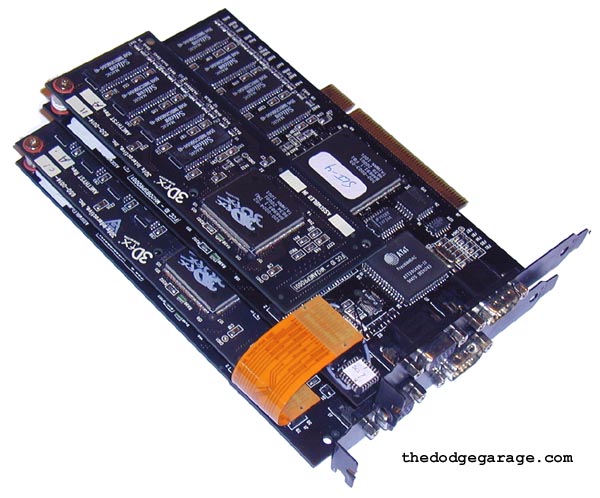
3dfx prototype and pre-production cards.
A word about the cards on this page- To generalize they are boards that were manufactured by 3dfx direct and not yet available to the general public. The boards fall into a number of different categories and I'll try to break them up below.
Developer kit boards- 3dfx sent developer kits out to the various companies that made video cards, included in the kits of course would have been several sample boards known as "reference" cards. Before 3dfx came along most third party board makers seemed to make their own PCB designs. After the Voodoo Graphics and Voodoo 2 hit the market and there were so many players involved in selling cards most manufactures could not afford to "be different" and were content to sell cards based off the reference design (a trend that continues to this day.)
Perfect example of boards most likely from developer kits below would be the Voodoo 2 & Banshee with SDRAM. They are clearly pre-production due to date codes and/or internal 3dfx markings and production cards from a number of companies follow their design.
Press "preview" boards? Less certain of being developer kit boards would be the Banshee with SGRAM and the black PCB Voodoo 3 as those PCB design numbers are rarely if ever seen. Build dates, bios revisions or PCB features clearly indicate they are not production cards... this is an area I have to look into further to find out where these cards fit into the scheme of things. It's possible these two cards are samples that were sent out to the press for "preview." The only place I have seen these two PCB designs were in such articles and will show the "press" versions for comparison. Another note about press cards... writers liked to use terms like "Alpha" & "Beta" samples like the cards were software which I do not know if is a correct description or note. I'm going to check with several sites that did previews and see if 3dfx actually used those terms or the writers of the articles did.
Engineering samples- First run hardware samples, proposed designs that were intended for sale but never released to market or engineering exercises.
Perfect examples of first run hardware below would be the brown PCB Voodoo 3 and Daytona 32 MB DDR. The V5-6000 is a good example of hardware that was a dropped (falling into this category would be also the V5-5000 32 MB, I have seen several examples but have been unable to lay hands on yet.) The Voodoo 3 MCM was from an internal engineering exercise at 3dfx to see how small a PCB could be utilized, it is a very rare piece!
The IBM Daytona 16 MB DDR is a bizarre piece- People inside 3dfx indicate it was actually a prototype board modified for sale to IBM even though the chip was not slated for release till January! Sounds like someone needed some quick cash =)
So on one hand its a prototype board since it was not due for release for another 6-12 weeks at best, on the other hand it was a production card since it was sold to IBM.

Obsidian 100DB-2440- What might be the rarest of prototypes I own, an Obsidian Voodoo Graphics SLI rig with both boards dated 19-96 (May 5-9 1996) with handmade circuitry on one of the cards near the SLI connector. The complete setup came from a computer at 3dfx *before* Quantum3D was spun off March 31, 1997.
Quantum3d nor 3dfx ever offered this configuration (dual 50-2440 cards) for sale to the public!
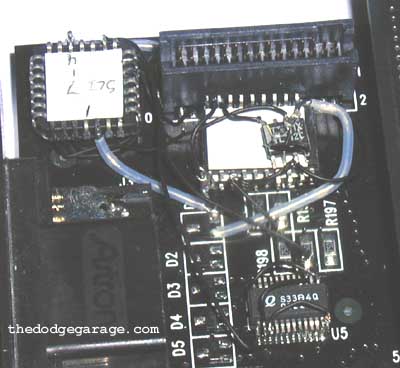
Other unusual features besides the hand wiring include black back-panels instead of chrome, AT&T "DAC" chip instead of the usual GENDAC brand and a decal that states "SLI-4." Production 100DB setups also have one card with no VGA connectors with a blank backplate just like the Diamond Multimedia Mega-Monster card.
Note- If you clicked on the "Production 100DB setups" link you will notice a red arrow pointing to the somewhat neater chip & wiring of the production board as compared to the prototype picture above.
Both boards function perfect as separate units and when run in SLI mode there is a notable increase in performance. However the computer monitor shows an interference pattern present when SLI is active. Not surprising at all considering that this is first run equipment. I'm looking to touch base with other 100DB owners to investigate further but the number of people who own & collect these cards can be pretty much counted on one hand.
The Obsidian 100DB-4440 had a MSRP of $2500 when it was released, pretty steep back in 1996.
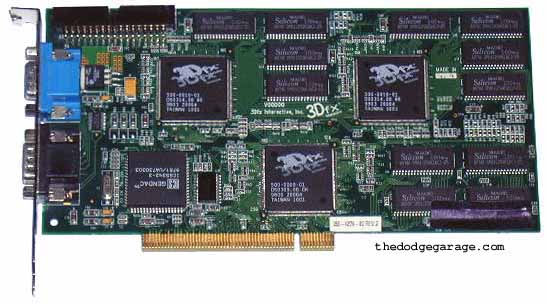
Pre-production or evaluation Voodoo 2 board direct from 3dfx. (CONFIRMED)
Creative Labs was the first to ship V2 cards to market on February 20th 1998 and this board is dated 08-98 (February 16th-20th). Now I'm mindful of the fact of course that cards are made and stockpiled before hand so that there is sufficient numbers on hand for a general release. So the fact that there is a card with a production date before Creative Labs release isn't very odd. However in the case of the initial V2 chip production 3dfx could only supply two vendors with sufficient numbers of chips for production- Creative Labs and Diamond Multimedia, two companies who were fanatical about marking their PCB's with their logos and stamps. This card doesn't have Diamond or Creative Labs logos but sure does have a big 3dfx Interactive Inc. dead center in the middle of the board. Other Asian board makers have used the "3dfx Interactive" logo on their cards but none of them had access to chipsets during this timeframe, just Diamond and Creative. Also there are several IC's on the board that are different from production pieces... that I have only noted on known pre-production or prototype cards.... Even the PCB is a different thickness then any other Voodoo 2 in my collection.
Also odd was that with this 8 meg board was a pair of 12 meg boards that were just 2-3 weeks older and one of them had 110 mhz ram which was unheard of back in early '98! The only production boards I have seen with 110 mhz ram were made well in the last week of December 1999 or later. Also absent from the board is any "CE" or Consumer Electronics markings indicating the product doesn't interfere with other electronic devices and has been tested safe and for consumer sales. Want more?
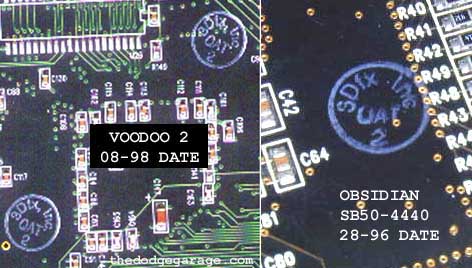
These stamps on the back of the V2 card- "3Dfx Inc." & "QAT 2" are identical to ones found on my new Obsidian SB50-4440 dated 28-96... A card assembled months before the first consumer Voodoo Graphics boards were even available to the public.
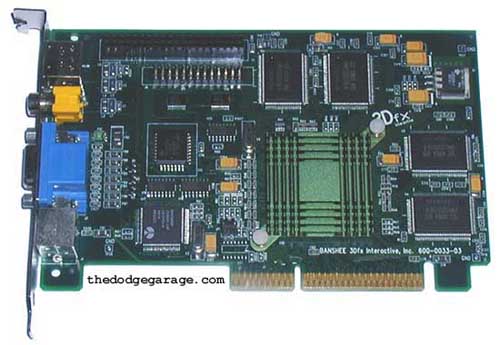
Banshee pre-production (24-98 date code) board with unknown 0.31 beta bios, 8 MB of SGRAM and RCA and S-video outputs. A number of boards described in the press as "alphas" were sent out as preview units, some even had fans! PCB #600-0033-03
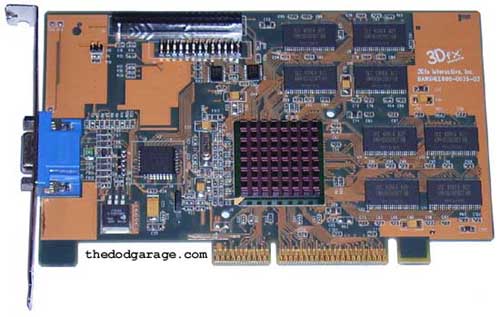
Banshee pre-production (34-98 date code) reference board, version 1.00.01 bios dated in Aug'98, 16 MB SDRAM. I spent a long time researching this board and comparing it to production units. It's very close to an Innovision Mighty Banshee except for the fact it was made months before Innovision released a Banshee for sale! It pre-dates the general Banshee release date by 6-8 weeks. I even went as far as to compare a number of Banshee SDRAM bios dumps with a hex editor looking for clues since the card is just about devoid of any markings. You would be surprised how little some of the production bios are changed from brand to brand, on most only the manufactures name on the boot up splash is different! Another clue besides the date is the missing FCC and CE markings and yellow resistors commonly used on pre-production 3dfx boards.
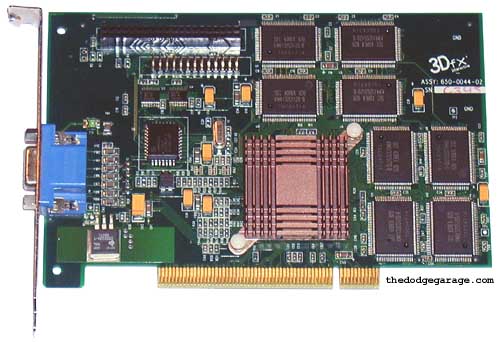
PCI Banshee developer board dated 36-98 (Sept 1-5, 1998), Banshee chip dated 35-98 (Last week in August, 1998) bios "1.00.01-ET" internally dated August 24th 1998 indicating card is "3Dfx Banshee Version 1.00 3Dfx Interactive, Inc."
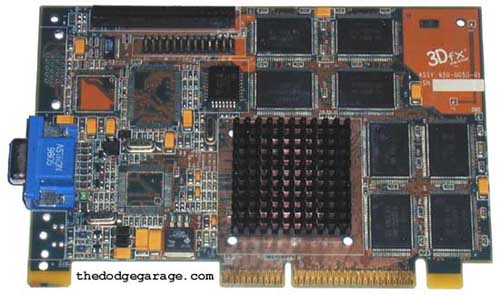
Prototype Voodoo 3- (52-98 date code) non-production 64k bios, ram rated for 166 mhz operation but not stable, currently clocked at 143 mhz and functions well.
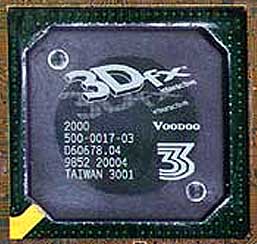
Notice the circle in the middle of the chip? Early samples used a heat spreader instead of a heatsink and the circle is the area where they came in contact with the chipset. PCB and ASSY #650-0050-01
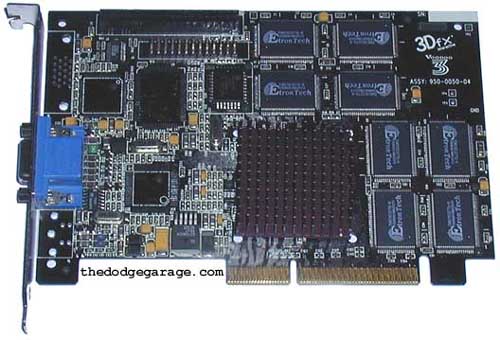
Pre-production (05-99 date code) Voodoo 3 clocked at 164 mhz card (notice triple Voodoo 3 logo). Interesting on this board is it has a black PCB, fan header location and poking around the bios has revealed the internal 3dfx name for the V3 "AVENGER". PCB #900-0050-03 ASSY: 950-0050-04 Click here to see screenshot of 3dfx tools info, click here to see press version of same card.
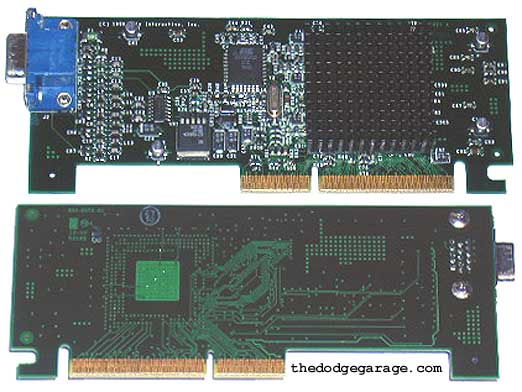
Voodoo 3 MCM- 1 of less then 12 engineering samples testing feasibility of manufacturing very small PCB V3 board, ram is located under V3 chip! Date code 26-99, PCB #600-0076-01 Rev. A. Dimensions are 6" long x 2" wide.
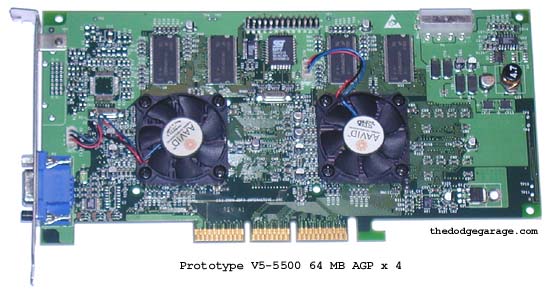
Can't tell you much about this card except state the obvious- A prototype V5-5500 AGP x 4 with 64MB. If the board looks shorter then a regular V5-5500 that is because it is by about a full inch. The card is dated 30th week of 2000 (11 weeks newer then my regular 5500's) and has PCB number 210-0411-001-A1.
The bios revision is 1.12 dated 7/21/00 and what is odd is there is no 3dfx bios display call out on boot up and things seem to be moved around the bios in different locations then stock. This board also has a number of components and resistors that have obviously been hand soldered in place or modified. Card function is flawless with stock VSA-100 drivers, even when 4x anti-aliasing is utilized.
I will go out on a limb and offer a theory- Judging by the date and configuration of the PCB, it suggests that this PCB would have superceded the longer board we know so well. It has an AGP x 4 connector, has a DVI spot on the PCB (perfect for G4 Mac applications) and compared to a normal V5 PCB is shorter and uses less components which saves money so you can offer the card at a lower price.
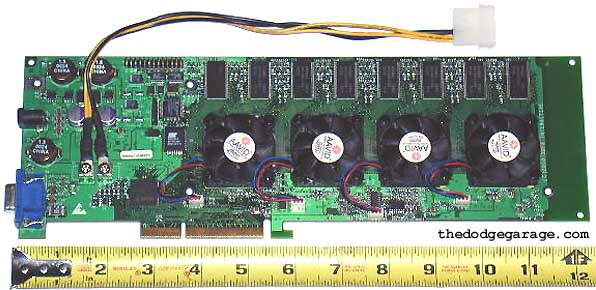
The 128 meg V5-6000
What was to be 3dfx's "ultimate" video card never made it to market due to extensive delays but a few sneaked out when they went under. This one has been fully reworked for proper operation and internal power connector. You can click here to see the V5-6000 display properties in a new window.
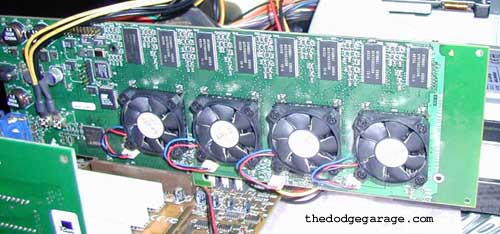
V5-6000 in action, revision 3700 A, date code 37-00, PCB #210-0391-001-A
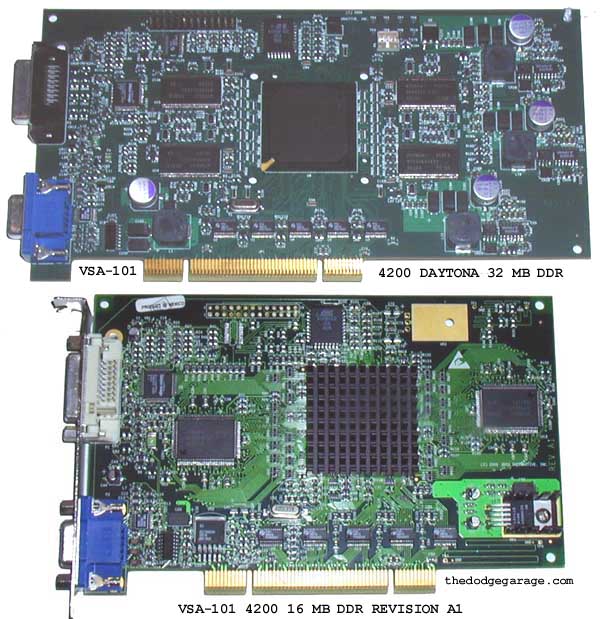
Pair of Daytona VSA-101 based cards, upper is engineering sample #2 with 32 mb DDR ram (Date code 35-00, PCB #210-0419-001-A1) and the lower is 16 mb DDR ram (Date code 46-00, PCB #210-0424-001-A1) prototype card modified for limited production. To see an even earlier VSA-101 example head over to the Daytona page.